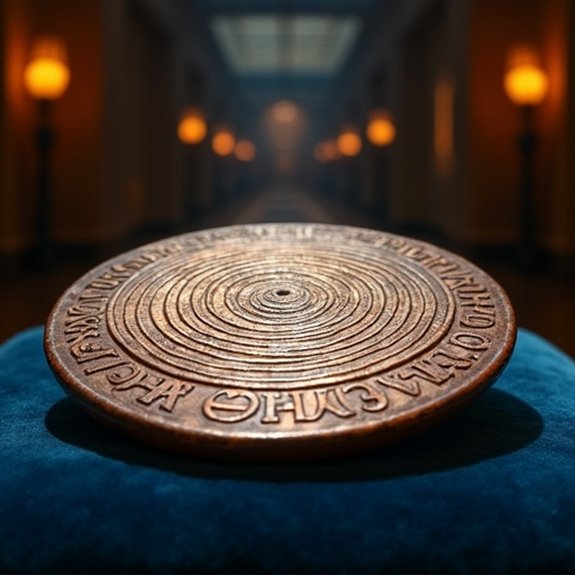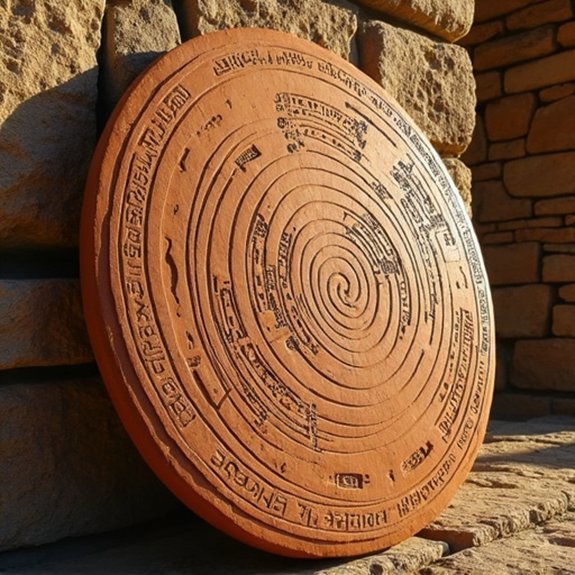The Mystery of the Phaistos Disc
The Phaistos Disc shouldn’t exist. Found in 1908 on Crete, this clay artifact’s 241 symbols don’t match any known ancient script. Archaeologists can’t agree whether it’s a religious text, farming calendar, or elaborate fake. After a century of failed decoding attempts, the disc guards its secrets while raising an unsettling question: what if humanity’s lost an entire civilization’s language?
Introduction

When archaeologists discovered the Phaistos Disc in 1908 on the island of Crete, they’d uncovered one of history’s most puzzling artifacts. The clay disc measures approximately 15 centimeters in diameter and features 241 mysterious symbols pressed into both sides in a spiral pattern. Italian archaeologist Luigi Pernier found it in the Minoan palace of Phaistos, dating it to around 1700 BCE.
The disc’s unique hieroglyphic script doesn’t match any known ancient writing system. Its symbols depict human figures, animals, plants, and tools, but scholars can’t determine their meaning or even the language they represent. The disc remains undeciphered despite over a century of study. Some researchers question whether it’s a genuine Minoan artifact or an elaborate hoax, though most accept its authenticity based on archaeological evidence.
Discovery in 1908 Crete
While excavating the ruins of the ancient Minoan palace at Phaistos in southern Crete, Luigi Pernier made his remarkable discovery on July 3, 1908. The Italian archaeologist found the clay disc in a small basement room alongside a broken tablet inscribed with Linear A script. The disc lay in a layer of black earth mixed with ashes and pottery fragments dating to around 1700 BCE.
Pernier’s team had been systematically exploring the palace complex when they uncovered this underground chamber. The disc’s pristine condition surprised them since the surrounding materials showed significant damage. Its unique spiral arrangement of stamped symbols immediately distinguished it from other Minoan artifacts. Pernier carefully documented the disc’s exact position and surrounding context before removing it for further study.
Notable Cases or Sightings

The Phaistos Disc‘s discovery sparked numerous attempts to decipher its meaning, leading to hundreds of proposed translations and interpretations over the past century. Scholar Luigi Pernier’s initial 1908 examination couldn’t determine the disc’s purpose or script direction. In 1975, Jean Faucounau claimed it represented an ancient Greek dialect, but linguists rejected his theory.
Steven Fischer’s 1997 declaration that he’d cracked the code attracted media attention. He argued it contained a Minoan prayer, though peers haven’t accepted his findings. Gareth Owens announced in 2014 that he’d decoded 99% of the disc using Minoan language comparisons, identifying references to a mother goddess. However, most archaeologists remain skeptical since there’s no similar artifact to verify these translations. The disc’s unique symbols and solitary nature make verification impossible without discovering comparable texts.
Common Theories or Explanations
Despite decades of scholarly debate, researchers have proposed several competing theories about the Phaistos Disc‘s true nature and purpose. Some scholars believe it’s a religious hymn or prayer text, possibly used in Minoan ceremonial contexts. Others argue it represents an ancient board game, with the spiral pattern serving as a playing field.
A popular theory suggests it’s an administrative document, perhaps recording property ownership or agricultural inventories. Linguist Gareth Owens claims he’s partially deciphered it as a prayer to a Minoan goddess. Meanwhile, some researchers propose it’s a calendar or astronomical chart tracking lunar cycles.
More controversial theories include it being a magical incantation, a legal code, or even a Bronze Age hoax. The disc’s unique symbols and lack of comparable artifacts continue fueling speculation among archaeologists worldwide.
Frequently Asked Questions
Can Visitors See the Phaistos Disc in Person Today?
Yes, visitors can see the authentic Phaistos Disc at the Heraklion Archaeological Museum in Crete, Greece. It’s displayed in a climate-controlled case where tourists can view this mysterious 3,700-year-old clay disc with its undeciphered symbols.
How Much Does the Disc Weigh?
The Phaistos Disc weighs approximately 908 grams or about 2 pounds. It’s made of fired clay and measures roughly 16 centimeters in diameter with a thickness that varies between 1.6 and 2.1 centimeters across its surface.
What Preservation Methods Are Used to Protect the Disc?
Museum conservators protect the Phaistos Disc through climate-controlled storage with regulated temperature and humidity levels. They’ve placed it in a secure display case with specialized lighting that won’t damage the ancient clay artifact over time.
Have Any Similar Discs Been Found Elsewhere?
No authentic similar discs have been discovered elsewhere. While archaeologists’ve found other Minoan artifacts with hieroglyphic and Linear A scripts, the Phaistos Disc remains unique in its spiral arrangement, stamped symbols, and clay composition.
What Technology Has Been Used to Analyze the Disc?
Scientists have employed various technologies to analyze the disc, including X-ray fluorescence spectroscopy to determine its clay composition, 3D scanning for detailed surface mapping, and thermoluminescence dating attempts to verify its age and authenticity.


